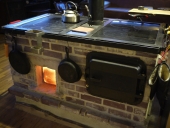Al, read line 5 in my original post, and thank you for your one suggestion of using larger diameter pipe coils.
Bill, thank you for your great reply! I also had the same understanding as you about containing all the heat possible until the air leaves the heat riser then it's free game to steal energy from. If this wasn't the case wouldn't the barrel be insulated as well?
As you mentioned 1 lb of wood would heat that water in a hurry, theoretically. I have built one of these already but I couldn't get it to draft properly. I think I had wet white poplar. I just brushed the snow off and cut it out of the bush, it was dead fall or dead standing. I have 1 year seasoned white birch for my next test. I built one similar to design #1 except the top of the reservoir was open, no lid, and I just filled it with snow then fired it up to see how long it would take to boil then I would have a bit more info. That was on a 6" round duct feed, burn tunnel and riser all housed in a 55 us gal drum. I think that is marginally enough room to have an adequately tall enough heat riser. So after much tinkering the thing didn't work properly so I never did get to boil the water. The prototype I made a week before did get the top center of the barrel to over 900F, pegged my thermometer.
I was thinking if you can get 900F at the top center of the barrel and alot of people say they have 300F leaving the barrel that would be safe to say you are utilizing 60% of the available heat before it leaves the barrel. Does anyone have any info on how many lbs/hr 49 sq in system would use? Until then I will assume 16 lbs/hr.
16lbs is potentially 96,000 BTU, if the stove is 90% efficient in converting the wood to heat you have 86,400 BTU to play with. Based on last assumption of using 60% of the heat in the barrel you have 51,840 BTU to use in the barrel. If you could capture all 51,840 BTU into the water, which you won't because you'll still be losing some through the barrel walls, you could heat 518 lbs of water by 100F or 51.84 imp gallons, much easier conversion than us gal.
You now need to move 51.84 imp gal, 235L or 61 us gal every hour. That is .86 imp gal per minute. Pretty slow pump. Even if you could capture all 96,000 BTU into the water you would need to move 1.6 imp gal per minute. If you doubled the wood consumption to 32 lbs/hr and kept the 100% efficiency and 100% capture rate you still only need to move 3.2 imp gal per minute.
If I only wanted to run this thing for 4-6 hours a night and I'd like my 50 imp gal tanks at 185F when the stove shuts off for the night, I need to heat tank 1 by 45F = 22,500 BTU, tank 2 by 63F = 31,500 BTU, tank 3 by 81f = 40,500 BTU and tank 4 by 100F =50,00 BTU I need a total of 144,500 BTU. 144,500 BTU spread out over 4 hours is 36,135 BTU/hr. Judging by these rough calculations that don't account for thermal losses to the air the 16 lbs/hr would be too much. 11 lbs/hr would be better. Or I could add more water tanks or have larger water tanks to absorb more BTUs. But as we all know things in practice don't always work as they were planned in theory.
I would love to hear from someone who has tried the coil or the reservoir so I can get an idea of many many BTUs will end up transferring into the water.
Am I missing something here because I don't see what makes these things Big Al's "flaming units of death".
Bill that is great that you have a boiler background that is a great resource in getting one of these rocket heaters successfully converted into a useful water heater. Keep the GOOD suggestions coming.






